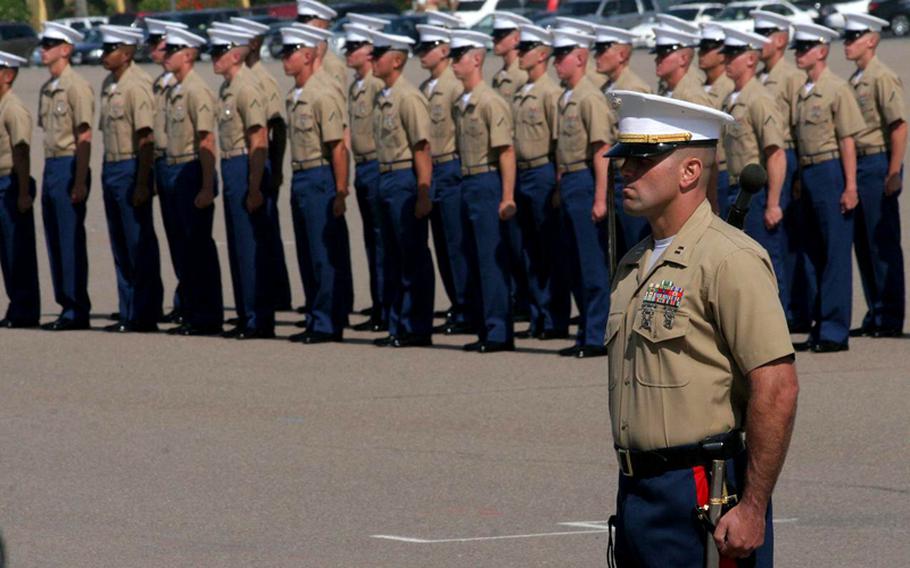
Marines stand in formation awaiting the arrival of Defense Secretary Robert Gates on Aug. 13, 2010, at Marine Corps Recruit Depot San Diego. Gates presided over the graduation of 196 recruits in six platoons. (Kevin Baron/Stars and Stripes)
NAVAL AMPHIBIOUS BASE CORONADO, Calif. — Under the hot summer sun, facing the strong sea wind, 67 of the Navy’s premier sailors vying to become SEALs stood at attention on the beach Friday, heads down, faces caked in sand, skin burned, life jackets on, ready to grab their small zodiac boats and enter the sea yet again.
They might have thought they were hallucinating by this seventh day of “Hell Week” when they were ordered to turn around and rush up a sand dune lined with superior officers. There, in the middle, stood a frail, white-haired Defense Secretary Robert Gates.
Barely audible even with a bullhorn, Gates uttered words they were hoping to hear. “Hell Week secured,” he said, setting off an enormous cheer from the sweating, exhausted men who formed a spontaneous group hug.
These Basic Underwater Demolition/SEAL students, called BUDs, had just finished what many of them likely think is the hardest part of their training at the Naval Special Warfare Center. But this is just the beginning. The sailors — the only ones remaining out of an initial class of 180 — have another 17 months of even tougher training before they get to wear the trident patch.
Gates’ surprise wrapped up a two-day visit to the California coastline, where he also presided over the latest company of 196 Marines to pass through basic training at the San Diego recruit depot.
Marines west of the Mississippi River come here when they enter the corps; recruits in the east go to Parris Island, S.C. In autumn and winter, the size of graduating companies in San Diego can swell to over 500 as the year’s high school seniors make their way into the military, totaling about 20,000 new Marines each year, according to one base official.
On Friday, the secretary thanked the cheering families for supporting their children’s decisions to serve, especially during the current conflicts. Gates noted that last year at Camp Lejeune, N.C., when one unit’s assignment was switched from Okinawa to Afghanistan about 100 of its Marines who were expected to retire from the service instead re-enlisted.
“That tells you a few things about United States Marines,” he said.
“For my part, I will do all I can to see that you have everything you need to accomplish your mission and come home safely, because I feel a deep, personal responsibility for each and every one of you as if you were my own sons.”
Gates then moved to a training ground to inspect the next batch of recruits as they sweated through intense pre-combat training, crawling in the dust, sparring with each other, shouting constantly to simulate the noisy battlefield — everything short of live fire — before calling them to huddle up for a few words of encouragement.
Asked later about his personal connection to the young recruits, Gates said that being a former president of Texas A&M University probably has made it harder. “I spent four-and-a-half years watching 18- to-25-year-olds walk on campus in flip-flops, shorts and T-shirts and backpacks, have fun and go to class,” he said. “And then, in an instant, I was watching kids exactly the same age in full body armor in Iraq and Afghanistan.”
The secretary flew home to Naval Air Station Whidbey Island, in Washington state, where he will take a summer vacation before returning to Washington, D.C., at the end of the month.